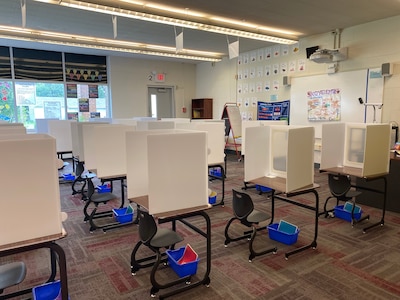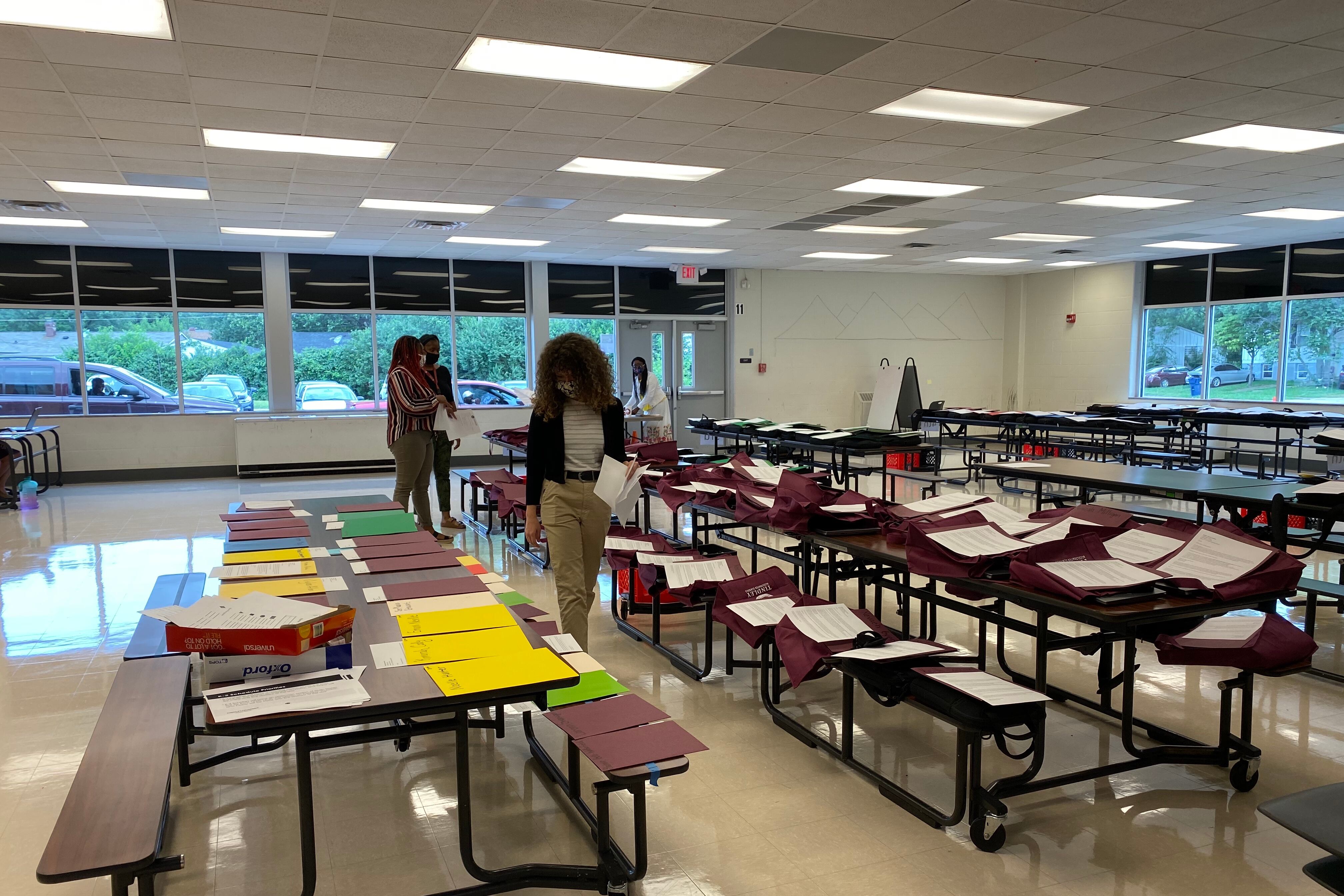On the first day of school for Tindley Summit Academy, a student bounded up and peered through the windows of the cafeteria, waving to her teachers inside.
The cars lining up in the parking lot Monday weren’t dropping off students to spend the day in classrooms. Instead, families were picking up food and Chromebooks for an unconventional virtual start to the school year.
Like many other schools, the Indianapolis charter school on the far eastside is navigating a late change in plans, pushing back the return to in-person learning due to the spread of the coronavirus. With reopening rescheduled for Aug. 17, and two weeks of virtual learning in the meantime, Tindley Summit educators had nearly 300 Chromebooks to distribute.
But a school is still a school, and Principal David McGuire is eager for students to come back.
“We’re doing what we feel is best,” he said. “Safety first, but then kids have to learn.”
While many across the nation fret over whether it’s safe to send students back to school, McGuire faces the uncertainty with a calm confidence, not fear. If the plans have to change again, they will. And if he’s anxious about the virus, he doesn’t want his teachers, families, or students to see it.
“I have to be fine so they see it’s OK,” McGuire said.
Most of his families want their students to come back in person. So McGuire sees his job as taking care of the obstacles that stand between teachers teaching and students learning: Feed families, hand out computers, revamp classrooms.
“Mr. McGuire,” a school staff member calls out to him, relaying a concern about a parent getting laptops for her children.
“Tell her I’ll bring her the Chromebooks,” he says.
“Mr. McGuire,” another question comes about a parent who enrolled her children recently and needs their school email addresses and log-in information.
“Get mom’s email address,” he responds. “We’ll get it to her.”
“Mr. McGuire,” a parent says, looking for help finding school uniforms.
“I’ll be with you in just a second,” he promises.
The school, which last year served about 300 students, is ready. Even in the kindergarten classrooms, desks sit spaced out in rows, each with its own three-walled plastic shield, like tiny cubicles where students can take off their masks. Inside the shield, some have stickers with a calming breathing exercise: “Take a deep breath. 1, 2, 3, 4, 5….”
Gone are the carpets for circle time and the bean bags for reading buddies. The tables for small-group instruction are pushed into the corners, still usable but a little less useful.
“This is not the start of the year we planned for,” said second- and third-grade English/language arts teacher Ashley Hogan. “It kills me, not being able to have our read-aloud carpet. My babies love it.” But, she added, “we’re still going to move mountains.”
Numerous signs posted throughout the school remind people to wash their hands and wear their masks. Each classroom has new hand sanitizer dispensers installed by the door. Boxes filled with masks and face shields for students occupy the storage room, as in-demand this year as pencils and computer paper.
The school will spell out the new health and safety rules when the building opens for instruction and will stress them the same way teachers outline behavioral expectations for students.

For the Tindley charter network of three schools with about 1,200 students, Chromebooks and the new safety measures have cost about $500,000, officials said, mostly paid for through federal funds for coronavirus relief and educating students from low-income families. More than 90% of Tindley Summit students qualify for subsidized meals.
For many families, it was important to see the changes during back-to-school nights last week. Only about 40 students have opted for all-virtual instruction this fall.
“It’s just going to look different,” McGuire said, but he thinks once students and teachers get through the initial shock and adjustment, it will feel like school as usual.
Students are still enrolling, and some parents have been waiting to see how schools are approaching reopening. McGuire expects a flood of new students when classrooms open Aug. 17, but the fluctuating numbers make it difficult to plan for spacing in classrooms.
“Mr. McGuire,” someone calls out, “are these the extra Chromebooks?”
He points her to the cart of spare Chromebooks that he set aside.
Each student in every grade having their own Chromebook will change the way education looks, even when students come back to school. This, McGuire says, is a good change: Students will use devices for school, not just for video games.
But virtual learning also keeps him up at night, as he worries about ensuring students still have as rigorous instruction as they would in person. It’s especially important when students could be dealing with learning loss from both the spring and summer.
McGuire talks less about the other thing that weighs heavily on his mind: the possibility that someone will get sick. The school has a plan, and everyone is being cautious. Before he picks up his 1-year-old daughter from day care, McGuire goes home to shower and change clothes.
During the back-to-school orientations, students rushed to him for hugs. They’re used to greeting their teachers in the mornings at the classroom door with hugs, handshakes, and fist bumps. Air hugs and hand sanitizing will help, but when a student in a Sonic the Hedgehog mask walked into the school on Monday, a teacher didn’t hold back from wrapping him in a big hug.
“Kids still gotta feel that love,” McGuire said.
In the Chromebook pick-up line, parents Ariel McMiller and Adashia Stone were ready to send their children back to school. Their children haven’t been sick yet, they said, and they trusted the school to keep their students safe.
Stone said she had been struggling since March to juggle her health care job with her daughter Cedrea’s remote learning. “She’d rather do in-person than online,” Stone added.
Cedrea bubbled happily at the thought of returning to school.
“I feel excited, I feel ecstatic, I feel everything about going back to school,” the third-grader said. “I can’t wait to learn new things, I can’t wait to see my teacher, I can’t wait to see my friends.”






